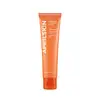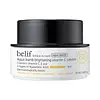What's inside
What's inside
 Key Ingredients
Key Ingredients

 Benefits
Benefits

 Concerns
Concerns

 Ingredients Side-by-side
Ingredients Side-by-side

Water
Skin ConditioningDipropylene Glycol
HumectantGlycerin
HumectantHydrogenated Polydecene
EmollientCetyl Ethylhexanoate
Emollient1,2-Hexanediol
Skin ConditioningNiacinamide
SmoothingPolyglyceryl-3 Methylglucose Distearate
EmulsifyingDaucus Carota Sativa Root Water
MaskingCetearyl Alcohol
EmollientStearic Acid
CleansingBeta-Glucan
Skin ConditioningGlyceryl Stearate
EmollientTromethamine
BufferingCarbomer
Emulsion StabilisingButylene Glycol
HumectantGlycine Soja Oil
EmollientRosa Chinensis Flower Extract
Skin ConditioningOcimum Sanctum Leaf Extract
Skin ConditioningAdenosine
Skin ConditioningCurcuma Longa Root Extract
MaskingDisodium EDTA
Xanthan Gum
EmulsifyingCitrus Aurantium Bergamia Fruit Oil
MaskingCorallina Officinalis Extract
Skin ConditioningPalmitic Acid
EmollientDaucus Carota Sativa Root Extract
Skin ConditioningBetaine
HumectantPanthenol
Skin ConditioningCupressus Sempervirens Leaf/Nut/Stem Oil
EmollientEucalyptus Globulus Leaf Oil
PerfumingMelaleuca Alternifolia Leaf Oil
AntioxidantDaucus Carota Sativa Seed Oil
EmollientEthylhexylglycerin
Skin ConditioningBeta-Carotene
Skin ConditioningTocopherol
AntioxidantCynanchum Atratum Extract
Skin ConditioningAcetyl Hexapeptide-8
HumectantCopper Tripeptide-1
Skin ConditioningPalmitoyl Pentapeptide-4
Skin ConditioningWater, Dipropylene Glycol, Glycerin, Hydrogenated Polydecene, Cetyl Ethylhexanoate, 1,2-Hexanediol, Niacinamide, Polyglyceryl-3 Methylglucose Distearate, Daucus Carota Sativa Root Water, Cetearyl Alcohol, Stearic Acid, Beta-Glucan, Glyceryl Stearate, Tromethamine, Carbomer, Butylene Glycol, Glycine Soja Oil, Rosa Chinensis Flower Extract, Ocimum Sanctum Leaf Extract, Adenosine, Curcuma Longa Root Extract, Disodium EDTA, Xanthan Gum, Citrus Aurantium Bergamia Fruit Oil, Corallina Officinalis Extract, Palmitic Acid, Daucus Carota Sativa Root Extract, Betaine, Panthenol, Cupressus Sempervirens Leaf/Nut/Stem Oil, Eucalyptus Globulus Leaf Oil, Melaleuca Alternifolia Leaf Oil, Daucus Carota Sativa Seed Oil, Ethylhexylglycerin, Beta-Carotene, Tocopherol, Cynanchum Atratum Extract, Acetyl Hexapeptide-8, Copper Tripeptide-1, Palmitoyl Pentapeptide-4
Water
Skin ConditioningDimethicone
EmollientPropanediol
SolventGlycerin
HumectantDiglycerin
HumectantTrehalose
HumectantDiphenylsiloxy Phenyl Trimethicone
Skin ConditioningPanthenol
Skin ConditioningSodium Chloride
Masking1,2-Hexanediol
Skin ConditioningSodium Hyaluronate
HumectantHydrolyzed Hyaluronic Acid
HumectantHydroxypropyltrimonium Hyaluronate
Sodium Hyaluronate Crosspolymer
HumectantSerine
MaskingSorbitol
HumectantDimethicone/PEG-10/15 Crosspolymer
PEG-9 Polydimethylsiloxyethyl Dimethicone
EmulsifyingPistacia Lentiscus Gum
MaskingLecithin
EmollientGlycine Soja Oil
EmollientTocopherol
AntioxidantAscorbic Acid
AntioxidantHelianthus Annuus Seed Oil
EmollientAscorbyl Palmitate
AntioxidantBeta-Carotene
Skin ConditioningDaucus Carota Sativa Seed Oil
EmollientDaucus Carota Sativa Root Extract
Skin ConditioningSalicornia Herbacea Extract
Skin ConditioningStellaria Media Extract
Skin ConditioningAlchemilla Vulgaris Leaf Extract
AntioxidantEquisetum Arvense Leaf Extract
AstringentUrtica Dioica Leaf Extract
Skin ConditioningAvena Sativa Kernel Extract
AbrasiveCalendula Officinalis Flower Extract
MaskingNepeta Cataria Extract
TonicRubus Idaeus Leaf Extract
Skin ConditioningBaptisia Tinctoria Root Extract
Skin ConditioningButylene Glycol
HumectantDimethicone/Phenyl Vinyl Dimethicone Crosspolymer
Sodium Citrate
BufferingEthylhexylglycerin
Skin ConditioningDipropylene Glycol
HumectantPentylene Glycol
Skin ConditioningAlcohol
AntimicrobialAlcohol Denat.
AntimicrobialRosmarinus Officinalis Leaf Oil
MaskingCitrus Aurantifolia Oil
CleansingPelargonium Graveolens Flower Oil
MaskingCitrus Aurantium Dulcis Peel Oil
MaskingLimonene
PerfumingCitronellol
PerfumingGeraniol
PerfumingCitral
PerfumingLinalool
PerfumingWater, Dimethicone, Propanediol, Glycerin, Diglycerin, Trehalose, Diphenylsiloxy Phenyl Trimethicone, Panthenol, Sodium Chloride, 1,2-Hexanediol, Sodium Hyaluronate, Hydrolyzed Hyaluronic Acid, Hydroxypropyltrimonium Hyaluronate, Sodium Hyaluronate Crosspolymer, Serine, Sorbitol, Dimethicone/PEG-10/15 Crosspolymer, PEG-9 Polydimethylsiloxyethyl Dimethicone, Pistacia Lentiscus Gum, Lecithin, Glycine Soja Oil, Tocopherol, Ascorbic Acid, Helianthus Annuus Seed Oil, Ascorbyl Palmitate, Beta-Carotene, Daucus Carota Sativa Seed Oil, Daucus Carota Sativa Root Extract, Salicornia Herbacea Extract, Stellaria Media Extract, Alchemilla Vulgaris Leaf Extract, Equisetum Arvense Leaf Extract, Urtica Dioica Leaf Extract, Avena Sativa Kernel Extract, Calendula Officinalis Flower Extract, Nepeta Cataria Extract, Rubus Idaeus Leaf Extract, Baptisia Tinctoria Root Extract, Butylene Glycol, Dimethicone/Phenyl Vinyl Dimethicone Crosspolymer, Sodium Citrate, Ethylhexylglycerin, Dipropylene Glycol, Pentylene Glycol, Alcohol, Alcohol Denat., Rosmarinus Officinalis Leaf Oil, Citrus Aurantifolia Oil, Pelargonium Graveolens Flower Oil, Citrus Aurantium Dulcis Peel Oil, Limonene, Citronellol, Geraniol, Citral, Linalool
Ingredients Explained
These ingredients are found in both products.
Ingredients higher up in an ingredient list are typically present in a larger amount.
1,2-Hexanediol is a synthetic liquid and another multi-functional powerhouse.
It is a:
- Humectant, drawing moisture into the skin
- Emollient, helping to soften skin
- Solvent, dispersing and stabilizing formulas
- Preservative booster, enhancing the antimicrobial activity of other preservatives
Beta-Carotene is a carotenoid. It is an antioxidant that converts to Vitamin A. Antioxidants help fight free-radicals. Free-radicals are molecules that may damage your skin cells, such as pollution.
It gives plants the red, orange, and yellow color. Some foods with Beta-Carotene include sweet potatoes, carrots, apricots, and cantaloupe.
Butylene Glycol (or BG) is used within cosmetic products for a few different reasons:
Overall, Butylene Glycol is a safe and well-rounded ingredient that works well with other ingredients.
Though this ingredient works well with most skin types, some people with sensitive skin may experience a reaction such as allergic rashes, closed comedones, or itchiness.
Learn more about Butylene GlycolDaucus Carota Sativa Root Extract comes from the root commonly known as carrot (the orange kind we eat!).
This extract contains beta-carotene, a pigment responsible for giving plants the orange color. Beta-carotene is a potent antioxidant. Antioxidants may help reduce the signs of aging.
Beta-carotene is the reason we turn orange if we eat too many carrots.
It should be noted coming into contact with the leaves of wild carrots can cause skin irritation. The sap causes phytophotodermatitis, or sensitivity exposed to sunlight.
This ingredient is created using the edible parts of the carrot.
Learn more about Daucus Carota Sativa Root ExtractDaucus Carota Sativa Seed Oil is the oil obtained from the seed of the edible carrot. The oil is created by steaming and distilling the seeds of the plant.
Carrot Seed Oil has hydrating, anti-inflammatory, and antioxidant properties.
As an emollient, carrot seed oil creates a thin film on the skin. This film prevents moisture from escaping, keeping your skin hydrated. Carrot seed oil has a soothing effect and can help alleviate inflammation.
As an antioxidant, carrot seed oil may help reduce the signs of aging. Antioxidants are able to neutralize free-radical molecules, or molecules that can damage our skin's cells and DNA.
Emerging studies show the alpha-pinene and carotol content give carrots antibacterial and antifungal properties. However, this is dependent on the amount of each compound. More studies are needed.
Carrot Seed Oil is not carrot oil. Carrot oil is created by mixing parts of the carrot in a carrier oil, such as coconut oil.
Learn more about Daucus Carota Sativa Seed OilDipropylene Glycol is a synthetically created humectant, stabilizer, and solvent.
This ingredient helps:
Dipropylene glycol is technically an alcohol, but it belongs to the glycol family (often considered part of the ‘good’ alcohols). This means it is hydrating and gentle on skin unlike drying solvent alcohols like denatured alcohol.
As a masking agent, Dipropylene Glycol can be used to cover the smell of other ingredients. However, it does not have a scent.
Studies show Dipropylene Glycol is considered safe to use in skincare.
Learn more about Dipropylene GlycolEthylhexylglycerin (we can't pronounce this either) is commonly used as a preservative and skin softener. It is derived from glyceryl.
You might see Ethylhexylglycerin often paired with other preservatives such as phenoxyethanol. Ethylhexylglycerin has been found to increase the effectiveness of these other preservatives.
Glycerin is already naturally found in your skin. It helps moisturize and protect your skin.
A study from 2016 found glycerin to be more effective as a humectant than AHAs and hyaluronic acid.
As a humectant, it helps the skin stay hydrated by pulling moisture to your skin. The low molecular weight of glycerin allows it to pull moisture into the deeper layers of your skin.
Hydrated skin improves your skin barrier; Your skin barrier helps protect against irritants and bacteria.
Glycerin has also been found to have antimicrobial and antiviral properties. Due to these properties, glycerin is often used in wound and burn treatments.
In cosmetics, glycerin is usually derived from plants such as soybean or palm. However, it can also be sourced from animals, such as tallow or animal fat.
This ingredient is organic, colorless, odorless, and non-toxic.
Glycerin is the name for this ingredient in American English. British English uses Glycerol/Glycerine.
Learn more about GlycerinGlycine Soja Oil comes from the soybean. Glycine Soja is native to eastern Asia.
Soybean oil is an emollient. It is rich in antioxidants and fatty acids including palmitic, stearic, oleic, and linoleic acids.
As an emollient, the fatty acids in soybean oil helps keep your skin soft and hydrated. It does so by creating a film on top that traps moisture in.
Soybean oil is also rich in vitamin E, a potent antioxidant. Vitamin E is also anti-inflammatory and provides a soothing effect.
Studies show soy may help fade hyperpigmentation from UVB. It does so by disrupting the melanin process from UVB induced skin inflammation.
This ingredient may not be malassezia folliculitis, or fungal-acne, safe.
Soybeans are rich in proteins and are part of the legume family. Foods made with soybeans include tofu, soymilk, edamame, miso, and soy sauce.
Learn more about Glycine Soja OilPanthenol is a common ingredient that helps hydrate and soothe the skin. It is found naturally in our skin and hair.
There are two forms of panthenol: D and L.
D-panthenol is also known as dexpanthenol. Most cosmetics use dexpanthenol or a mixture of D and L-panthenol.
Panthenol is famous due to its ability to go deeper into the skin's layers. Using this ingredient has numerous pros (and no cons):
Like hyaluronic acid, panthenol is a humectant. Humectants are able to bind and hold large amounts of water to keep skin hydrated.
This ingredient works well for wound healing. It works by increasing tissue in the wound and helps close open wounds.
Once oxidized, panthenol converts to pantothenic acid. Panthothenic acid is found in all living cells.
This ingredient is also referred to as pro-vitamin B5.
Learn more about PanthenolTocopherol (also known as Vitamin E) is a common antioxidant used to help protect the skin from free-radicals and strengthen the skin barrier. It's also fat soluble - this means our skin is great at absorbing it.
Vitamin E also helps keep your natural skin lipids healthy. Your lipid skin barrier naturally consists of lipids, ceramides, and fatty acids. Vitamin E offers extra protection for your skin’s lipid barrier, keeping your skin healthy and nourished.
Another benefit is a bit of UV protection. Vitamin E helps reduce the damage caused by UVB rays. (It should not replace your sunscreen). Combining it with Vitamin C can decrease sunburned cells and hyperpigmentation after UV exposure.
You might have noticed Vitamin E + C often paired together. This is because it is great at stabilizing Vitamin C. Using the two together helps increase the effectiveness of both ingredients.
There are often claims that Vitamin E can reduce/prevent scarring, but these claims haven't been confirmed by scientific research.
Learn more about TocopherolWater. It's the most common cosmetic ingredient of all. You'll usually see it at the top of ingredient lists, meaning that it makes up the largest part of the product.
So why is it so popular? Water most often acts as a solvent - this means that it helps dissolve other ingredients into the formulation.
You'll also recognize water as that liquid we all need to stay alive. If you see this, drink a glass of water. Stay hydrated!
Learn more about Water